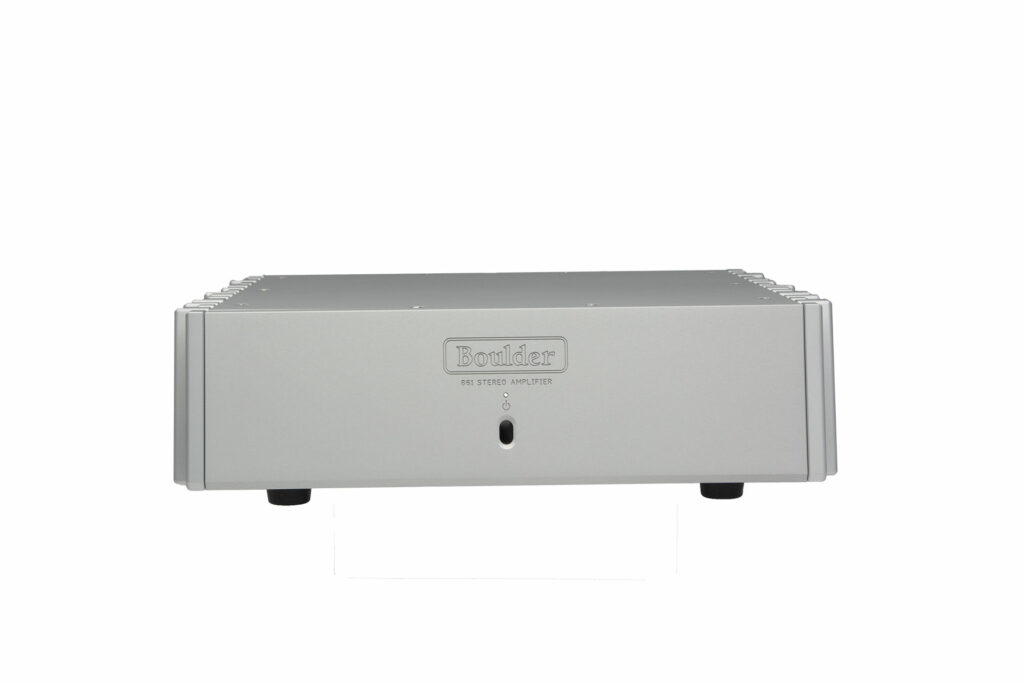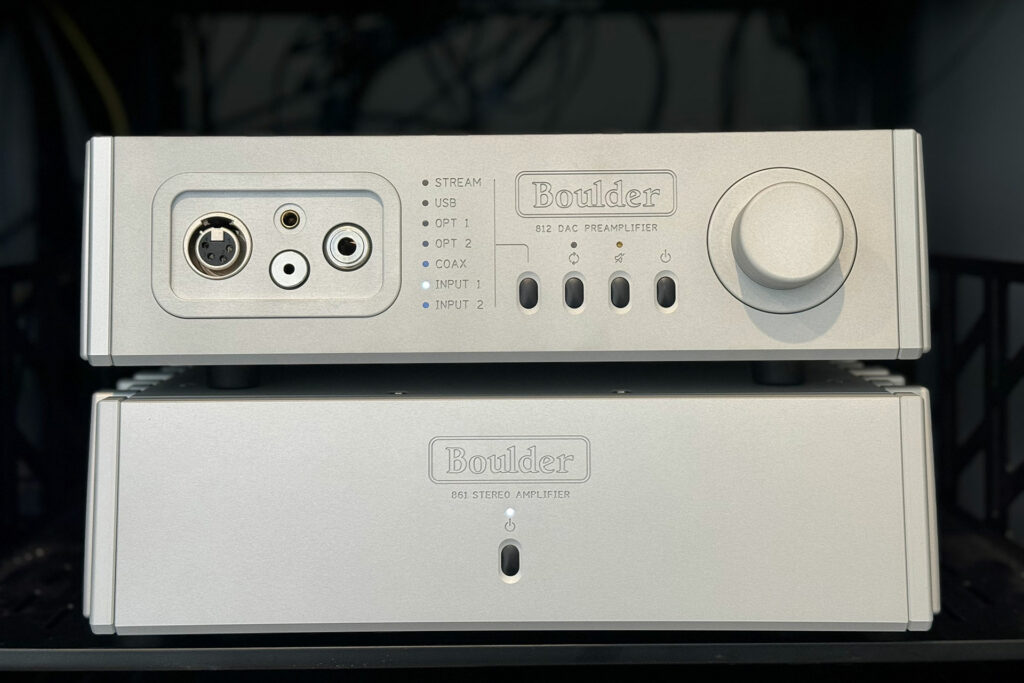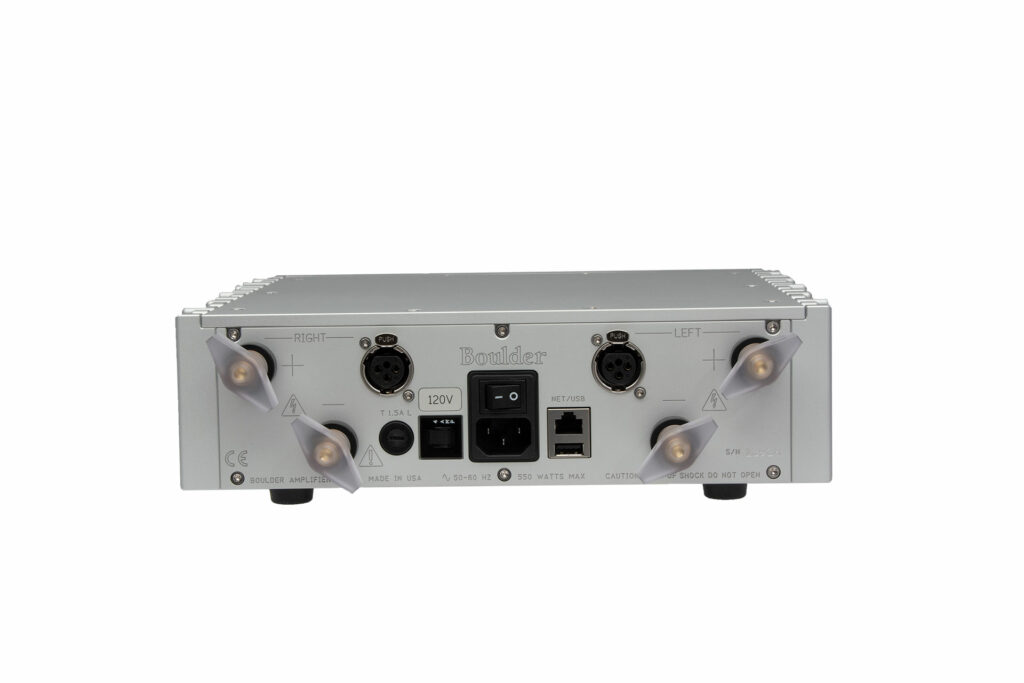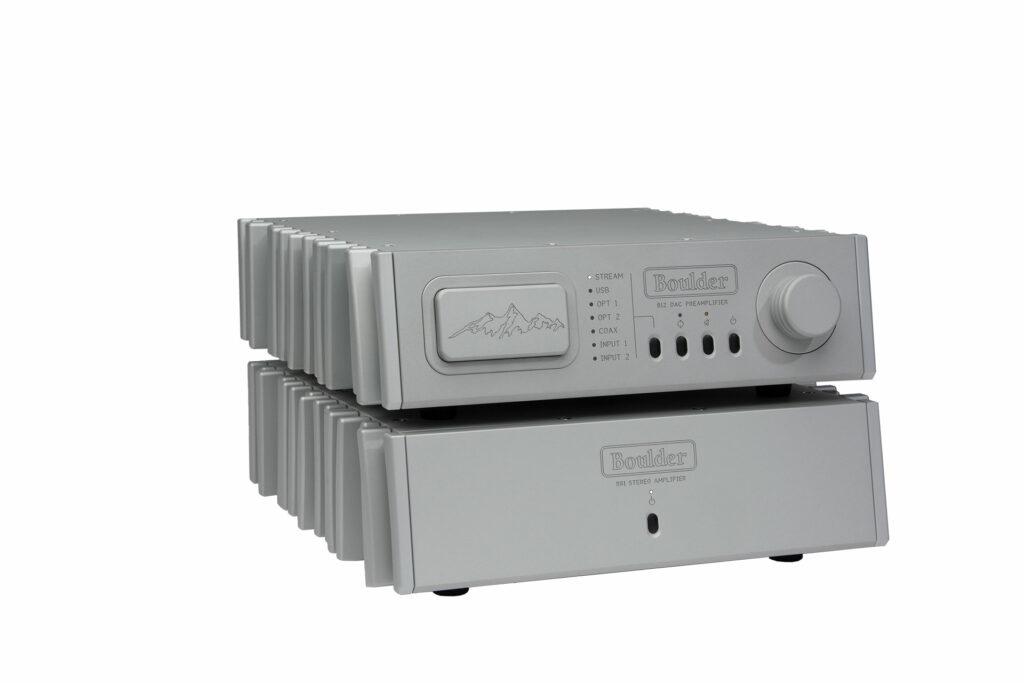There is a lot of exotica in the audiophile hobby and, when it comes to power amplifiers, Boulder is likely to land at the front of the pack. Jeff Nelson’s team in Boulder, Colorado designs and builds some of the elite finest power amplifiers that money can buy. Boulder’s 3000 Series power amps are among the biggest, most powerful and most resolved amps in the audiophile world and, for over $200,000 per pair of monoblocks, that’s a fair expectation. The idea that a Boulder Amp can be had for $9,250 is purely uncharted territory for audiophiles, but that’s thankfully where we stand today, because of the new, smaller form factor Boulder 861 audiophile amplifier.
The Boulder 861 is the matching amp that pairs with the $9,250 Boulder 812 DAC/Preamp (read the review), which I have also recently reviewed. The Boulder 861 is a more traditional Class-AB design that Jeff and his team have built around delivering very high-current power over what seems like comparatively modest power output. Don’t let the somewhat low power output fool you, because the Boulder 861 is a very capable power amp that can drive even two-ohm loads with ease, with upwards of 200 watts of power per channel.
In the $10,000 audiophile amp range, there is a lot of stiff competition from some companies that deliver their reference amps at this price point. For Boulder, delivering an under $10,000 power amp is all new (and pretty exciting). Is their new design worthy of the hype? That is what I am here to discover for you…

What Makes the Boulder 861 Power Amp So Special?
- High current is the calling card of the Boulder 861. While the amp reports a conservative 75 watts of peak output into eight ohms, it can deliver 200 watts of power into two-ohm impedance speaker loads. This doesn’t sound like a ton of power, but the Boulder 861 is able to power even more demanding audiophile speakers without a hiccup.
- Like many amps in this class, the Boulder 861 operates in pure Class-A for the first 10 watts or so. Opening up with Class-A operation isn’t uncommon in the world of Class-AB amps, but what is rarely mentioned is that most audiophiles rarely ever get past the first few watts in most of their listening. Cool audiophile amp gauges (think: Pass Labs, McIntosh, Vinnie Rossi, D’Agostino) will show you this concept as you watch the needle bounce back and forth. Those big power outlays are generally for very, very short bursts of power, and last milliseconds.
- I couldn’t have raved more about the build quality and the metalwork on the Boulder 812 DAC/Preamp, and the same goes for the Boulder 861. This is slightly smaller than standard form factor amp, and is staggeringly beautiful to the eye, as well as the ear. The metalwork (all but the anodizing) is made in-house in Colorado, a process that I’ve seen with my own two eyes. The Boulder 812 and 861 sit together as a beautiful amp/preamp combo. The heat synchs on the side of the amp are artful and unique in their design in ways that you’d expect from a top-level designer.
- The Boulder 861 doesn’t create much heat. My reference amp from another iconic American audiophile brand, the Pass Labs XA-25, is a $5,150 unbalanced amp that is Class-A for the first 25 watts and sounds absolutely great. Its issue is that it goes full Buster Poindexter (aka: hot, hot, hot) when the Boulder 861 runs cool – more like today’s new-school Class-D (GaN, Pascal or Hypex chip amps).
- The Boulder 861 is a fully balanced amp. Minds have been blown explaining to a new audiophile how amps can have XLR inputs, but not be truly balanced in terms of the design and/or circuitry. The Boulder 861 is a fully-balanced amp design, which tends to be a little bit more quiet in terms of operation, which is always a good thing in the audiophile world.
- Like many of today’s most cutting-edge digital components, the Boulder 861 can connect to your network via USB. Why is this important? Such a network connection allows for software updates and potential service from a distance, which is the way things should be for a nearly $10,000 audiophile components. Not every AV company delivers on this level of connectivity, but Boulder does.
- The speaker binding posts on the Boulder 861 are made in-house. They are very luxurious and as easy to work with as any that I have ever used in my system, or even in any high-end amp that I’ve owned. On my factory tour before last year’s CEDIA trade show, I learned how Boulder had a supply chain issue with speaker binding posts during the pandemic. That isn’t a shocker, as that was one of the big eye-openers from that era in terms of manufacturing. What was cool was how Boulder uses their many CNC machines to make their own parts that are this fantastic.
Why Should You Care About the Boulder 861 Power Amp?
You’ve always wanted a Boulder amp. Every time you see one at an audiophile show, you stop and listen (and likely drool, despite the explicit chance that you could electrocute yourself that way). But the idea of draining your kid’s college education fund for your audiophile needs is sometimes a line too far … until now. The Boulder 861 gives you a path to own a legitimate Boulder power amp with a big but not insane price tag. If Ferrari made a $75,000 “Corvette killer,” you might have to give it a test drive, because at $300,000, an entry-level prancing horse is a non-starter for most of us. At $75,000, more of us might be able to find an extra garage spot for such a special Sunday driver. The Boulder 861 falls into that “Dino-like” category, but you can drive this one every night for the rest of your life, and it really does sound/feel like a Boulder product.

Some Things You Might Not Like About the Boulder 861 Amplifier
- We rave about the Boulder 861 being a balanced amp, but there are no built-in provisions for unbalanced (RCA) inputs. Ironically, my reference Pass Labs amp has the opposite problem and, if given a choice, I would opt for the Boulder option in terms of balanced-only operation over RCA-only. You can absolutely use quality XLR to RCA adapters if switching cables is just an impossibility or is cost-prohibitive. Be sure to get good adapters, or just buck up for new cables completely, if that makes more sense.
- The Boulder 861 is diminutive in size (width), which is all the rage in the audiophile world today. This is a personal issue for me, but not all audiophiles agree. I like a full-width audiophile component (meaning 17 inches wide). The Boulder 861 does pair well with the 812 DAC/Preamp, which looks great as a pairing, but it would fit better in my rack if it were a full rack width. I know … I know. Picky, picky.
- Again, another trivial detail, but the number 861 reminds me of Meridian’s long-standing reference AV preamp, which I owned. I would have liked to see a different number used there, but for all that it matters, they can call it anything that they want. I don’t listen to model numbers – I listen to music, and music this amp reproduces quite well.
Listening to the Boulder 861 Audiophile Power Amp…
One of my best audiophile industry friends has flown to Las Vegas twice in recent months to see U2, as well as his favorite band ever, Phish, in the new Sphere venue. One of the bands that we both thought would be great in such an amazing $2,700,000,000 concert venue is Tool. Their song “Stinkfist” from the Aenima album is a hard-hitting, progressive track that sounded notably great with the Boulder 861 in the loop. This a lumbering, driving track, with lots of grungy but low bass guitar on the track that had an energy, with the Boulder 861 in the loop, that was as good as I’ve ever heard on my 90 dB Bowers & Wilkins 802 D4s. While I don’t think the Boulder 861 has much of a house sound, it does have that visceral bass impact that one likes from a Krell or today’s D’Agostino amp.
When we are training new reviewers, we suggest that in the spectrum of musical cliché (with zero cliché being some Icelandic flugelhorn music and 100 represented by the likes of Dark Side of the Moon, Hotel California, Blue Train, Kinda Blue etc …) Steely Dan’s Aja is about as close to 100 as you can get, if not all the way there. The good news is that, for audiophiles of any age, reviewers like me don’t have to explain to them what the song generally sounds like. The opening notes have a 1970s twang or phaser sound on the guitar that was so detailed and resolved with the Boulder 861 in my rig that I kept playing the opening of the track over and over again. I’ve heard “Peg” a million times in my system, as well as on radio, but I don’t remember this level of detail in the higher frequencies. In the chorus, King of Yacht Rock Michael McDonald’s background vocals are layered on top of Donald Fagen’s in a way that sound so rich and three-dimensional that I couldn’t believe it. When you are hearing new musical elements of Steely Dan’s Aja – you know you are dealing with a lot of resolution and detail.
In his recent memoirs, Foo Fighters frontman Dave Grohl talked about being asked to play “Blackbird” on an awards show – possibly The Oscars. He said that he was scared to death, as this isn’t the easiest song to sing or play on guitar. Major props to Beyonce for taking on such a musical challenge on her new “country” album Cowboy Carter. I love the layered but highly overdubbed arrangement. Queen B’s vocals were laser-focused in the middle of the soundstage with the Boulder 861 in my loop. The layering on the dubbed vocal harmonies was musically engaging but had a smooth, open sound that was unlike anything that I’ve ever heard. I know a lot of today’s music has that balls-to-the-wall “all levels to 10” feel, but the space, layering and depth made this Beyonce recording a great new-school audiophile demo track. Will I hear it in Munich? Unlikely, but stream this one in to your rig, and see if you agree with me. Mainstream people with the means would understand what a $50,000 to $100,000 audio system is good for when they hear relevant and popular music like this sounding that good.
Will the Boulder 861 Power Amp Hold Its Value?
Ask anybody who watches the used audiophile market, and they will tell you that Boulder rarely ever comes up for sale and, when it does, the components sell in the blink of an eye. The Boulder 861 and 812 are now selling like hotcakes, and some have had to wait for their amp and/or preamp to be made. That’s a good sign for future consumer demand of this series of products. The fact that the Boulder 861 is so relatively affordable also helps, in that if you took 40 to 50 percent off of the price of the Boulder 861 for the used market, you would open up the brand to a much larger audience than the crazy-expensive 2100 or 3000 Series products. That is if you can find one used, and that’s just unlikely at this point.
Another factor that helps with the long-term value of the Boulder 861 is its modest weight at 22 pounds. Even with a few extra pounds added in for packing, a Boulder 861 is easy to ship. No crate needed. No palette, either. Nor do you need to deal with a logistics company. You can just take an amp like the 861 to FedEx or UPS and send it on its way. I discussed this with the Boulder folks while at Axpona a few weeks back, and what it takes to send their reference gear to Munich is just insane. Not just in terms of cost, but the physics and logistics of getting their reference electronics to Germany and back. The Boulder 861 and 812 don’t have these problems.

What is the Competition for the Boulder 861 Power Amp?
There are so many good amps out there today in this price category that the Boulder 861 has stiff competition without question. One of the first amps that came to mind is the Classe Delta Power amp at $12,999 – read the review. This is a big-boy power amp that also offers its first few watts as Class-A power, and then converts to Class-AB, where it outputs much more power from a much larger and heavier audiophile amp. The bass on the Boulder amp was even better than the studio-grade sound that the Classe delivers (Classe is used in places like Abbey Road Studio in London).
While an unbalanced amp by design, Nelson Pass’ XA-25 (read the review) was a direct comparison that I was able to make in my reference system. Again, I liked the bass performance on my Bowers & Wilkins 802 D4 speakers (read the review) a little better with the almost-twice-the-price Boulder 861 in my rig, but I liked the openness and control of the Pass Labs XA-25 better overall. The big draw for me to the Boulder was its lack of heat, but I deal with that by actually turning off my Pass Labs amp when I am done listening, as it draws ALL of the power out of the wall, all of the time, and creates a lot of heat, which is just wasteful, as most of my listening is done at night, thus there’s plenty of time to warm up the Pass Labs, if you believe in that (I don’t, but I do like saving on my power bill when possible). The $10,500 Pass Labs X250.8 Class-AB amp is larger in form factor, but closer in price and perhaps an even better comp for the Boulder 861. Paul Wilson has the X250.8 in for review now.
The pink elephant in the room here is the growing number of new-school Class-D amps on the market today. Michael Zisserson bought his review sample of the AGD Productions Tempo di GaN (read the review) for $5,500 (Gallium Nitride) amp, which I also had a chance to hear in my system for a few weeks. The AGD had a lot of the characteristics of the Pass Labs amp, without any of the power or heat issues. Class-D amps tend to struggle a little bit more with low-impedance loads, where a Boulder or Pass will not. Newer brands don’t sell as well on the resale market, either. Sonically, the Boulder 861 performs above the AGD Tempo di Gan, even if it doesn’t have more power output. The Boulder 861 sounds a little bit more controlled in the bass and a little bit more open in the highs. I’ve heard other Class-D amps that I liked incrementally better, including the less expensive monos from Orchard Audio. The top Starkrimson Ultra 2.0 amp from Orchard Audio (read the review) in its dual mono configuration is even better, and likely more price-relevant. Amped America’s AMPED 2400 (read the review), with its Pascal chips and priced at $5,000, is very powerful and might have the closest level of control from this category of amps when compared to the Boulder 861. Atmosphere’s GaN monoblock amps (GaN) at about $6,000 per pair are in for review, which would be a fun comparison.

Final Thoughts on the Boulder 861 Power Amp…
The Boulder 861 delivers big-boy power to audiophiles with slightly less than big-boy budgets, and that is a very, very good thing. If you need a physical example of the term “audio jewelry,” the Boulder 861 lives up to every part of the definition. This is a truly hand-crafted audiophile component that comes with uncompromising design and outrageously good performance, especially for the money.
You can find a larger, more powerful amp, but I am not sure that you can find a better power amplifier in the audiophile world than the Boulder 861. The world of uber-audio seems absurd when you see some of the prices. That isn’t the case with the Boulder 861, as you get a taste of the rarest audio for an expensive but aspirational price. If you find a way to buy a Boulder 861, your speakers will thank you.
What do you think about Boulder’s new foray into more affordable audiophile gear? Could you be in the market? Would you go hear such a product if there was a dealer somewhat nearby? Comment below and we will approve it quickly (our comments are moderated for troll-reduction).




Boulder makes fine products.
That is a fine complement from a big CH Precision dealer.
We’ve got a CH M1.1 review coming (a $50,000 amp) in an upcoming issue.
I agree with you – Boulder is bad ass. I got to see how the stuff is made in Colorado about a year ago (before CEDIA) and it was EYE-OPENING.
I wanted to keep their gear but an $11,000 car repair put a crimp in my style. 🙂
I just wanted to say that I only recently found your site and that I find it interesting. I plan to your site on a regular basis. Keep up the good work.
We LOVE YOU!!!
Glad that you found the site.
You should SEE the stuff that I’ve got “in the can” over the next 90-120 days. High end stuff. Chi-Fi stuff. Moderate stuff. Everything. From the best companies. Estelon, Weiss, CH, Stenheim, Anthem, PS Audio, Cambridge Audio, Topping. SO MUCH MORE.